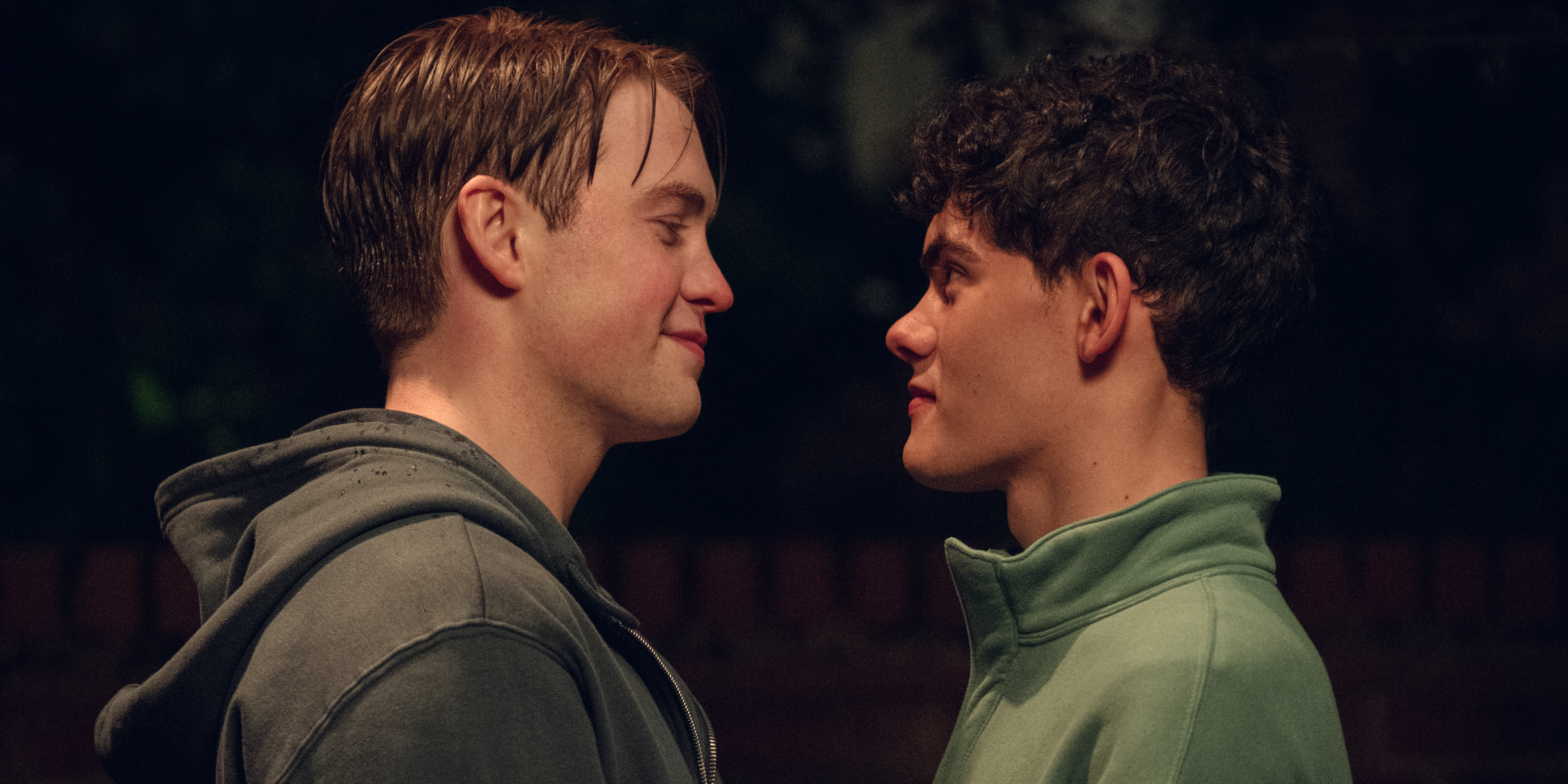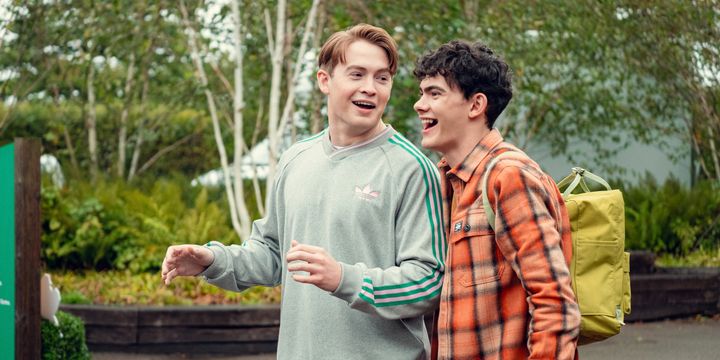
You can’t choose what happens to the people you love, or the choices they’ll make, or how their past trauma will impact their present lives. These are tough relationship lessons, lessons that you wouldn’t expect a teen TV show to explore. That’s what sets Netflix’s “Heartstopper” apart from its coming-of-age contemporaries.
The third season of the British teen show, which premiered last week, continues the love story between Nick Nelson (Kit Connor) and Charlie Spring (Joe Locke), now that Nick has come out as bisexual and their relationship is public. It is a faithful adaptation of the fourth and fifth volumes of Alice Oseman’s graphic novel series of the same name.
The first of the eight episodes picks up where the last episode of the second season ended. It’s summer, and Charlie is trying to figure out how and when to tell his boyfriend that he loves him, and Nick is worried that Charlie may have an eating disorder. Both conflicts surface when the two spend the day at the beach with their friends, and this juxtaposition between the universal and specific is what makes “Heartstopper”— both the TV show and comic — so exceptional.
“Heartstopper” captures the heightened emotions of being a teen and falling in love for the first time — the electricity that crackles between grazed fingers and bumped knees — while also showing how healthy, real love constantly reshapes itself as conditions in life change, becoming a force that steadies instead of constricts.
In the first episode at the beach, Charlie is sitting on a towel listening to music when Nick touches his cheek. They smile at each other.
“Come in the sea with me,” Nick says. “I really don’t want to take my shirt off,” Charlie responds. “Kay, well keep it on,” Nick tells him, before reaching out his hand to pull Charlie to his feet, and they enter the water with their fingers laced.
In the ocean, the two splash and play and, of course, kiss. As water drips off their faces, they lean their foreheads against each other, and the chemistry between them is palpable. It is a safe, loving moment, the one Charlie has been waiting for to say, “I love you.” But before he can get the words out, Nick tells him that he thinks he has an eating disorder. Black chaotic animation — the imagery the show uses to portray anxiety — fills the screen, creating a tunnel with Charlie’s face in the center; he is overwhelmed. But Nick is still there for him, standing in the current with him, supporting him even though he doesn’t know what to do, and loving him even though they haven’t exchanged those words yet.
This one short scene showcases how “Heartstopper” juxtaposes universal conflicts like when to say “I love you,” with specific challenges like mental illness to create a story that is full, and a relationship that is composed of small, beautifully complex moments.
Also, it’s almost the exact same as how it appears in the novel, exemplifying how Oseman, as both creator and writer of the show (she’s written all 24 episodes herself), continues to keep the show a faithful adaptation of her original work. The show also continues to use the animations from the novels — swirling leaves, zinging sparks, intruding darkness — to reveal the emotions of the characters and allow the viewer to experience the heightened feelings of a teenager.
Like the books, the show is evolving to include more mature topics, such as mental illness (specifically anorexia and Obsessive Compulsive Disorder) and self-harm, alongside the anticipated milestone of Nick leaving for uni (college). All of these internal and external conflicts take place within the progression of Charlie and Nick’s relationship — both emotionally and physically — but the progression, while still tender, is harder.

The first and second seasons of the show have been heralded for portraying unbridled queer joy. But I find that description to be an oversimplification that undermines how well-crafted and complex the show (and books) really are.
Even though this season of the show is heavier than the first two seasons, every season has explored big emotions and difficult subject matter. The first season begins with Charlie in an abusive, controlling relationship, and shows Nick learning about himself and his sexuality as he realizes that he is attracted to Charlie. The second season shows Charlie struggling with the loss of control he felt when he was bullied and in an abusive relationship by controlling his eating, and Nick is working through what it means to come out to friends and family.
It’s these complications that make “Heartstopper” feel so real, and it’s a testament to Oseman’s writing that the show still feels joyful with their inclusion. This is especially true in the third season, which is the heaviest of the three.
Nick and Charlie are learning that while being in love is joyful, it’s also hard. Sometimes love is holding someone close, but sometimes it’s letting them go — whether that be in-patient treatment or college. And that means that sometimes, being in love can feel lonely.
One of the most poignant moments of the season is when Nick dresses up in a Marvel costume for a Halloween party while Charlie is away at treatment. His missing of Charlie infuses the party montage with sadness and longing and despair. These are dark emotions that, until this season, the show has touched on but never explored in depth. That changes as Nick crouches in the hallway in his Marvel costume, sobbing, and the moment demonstrates how this season builds upon the way the show has always balanced darkness and light.
The fact that the show — beloved by fans for being lighthearted — can withstand moments like this is a testament to Oseman’s craft and the world she’s created. It’s the same when Nick visits Charlie in therapy for the first time. Even though Charlie’s mental illness is scary for both of them, they also just want to kiss and feel close to each other.
It’s this realness — this balance between light and dark and love — that ultimately puts “Heartstopper” in a category of its own. Reducing it to a teen TV show or LGBTQIA+ story undermines how rare and special it is.
Even within the world of adult television, most shows that center on a love story fall down the will-they-won’t-they rabbit hole, and I can’t name any other teen show that doesn’t use a love triangle to propel the plot and create cliffhangers between seasons. In “Heartstopper,” the drama is not will-they-won’t-they: It’s the real-life drama of what happens when you do love someone.
While I hope this special coming-of-age drama will continue for a fourth season, Netflix has yet to renew the series — and even if it does, there may be a bit of a wait. Oseman is only 50 pages into writing the sixth and final volume in the graphic novel series. Since the show follows the books so closely, she wants the book to be released before the corresponding season of the show comes out.
In the meantime, Oseman is continuing to publish new online installments of the comic that pick up where this season leaves off. Fans can also read her 2023 novella, which takes place after this season of the show has ended and before Nick leaves for college.
“Why are we like this?” is a common refrain over all three seasons of “Heartstopper.” In simplest terms, the answer is because Nick and Charlie are a true love story that is tender and awkward and complicated and imperfect, and audiences of all ages and sexual orientations are lucky to bear witness to them.
Disclaimer: The copyright of this article belongs to the original author. Reposting this article is solely for the purpose of information dissemination and does not constitute any investment advice. If there is any infringement, please contact us immediately. We will make corrections or deletions as necessary. Thank you.
